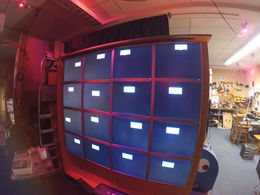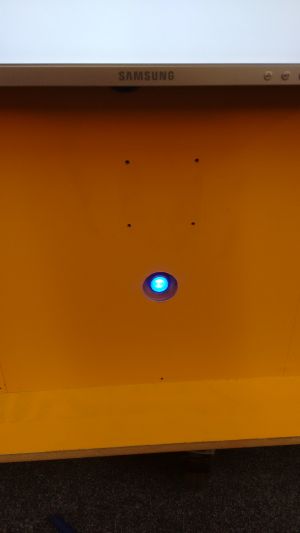16 Screen Wall: Difference between revisions
mNo edit summary |
No edit summary |
||
| Line 2: | Line 2: | ||
|Name=16 Screen Wall | |Name=16 Screen Wall | ||
|Skills=Linux, X, | |Skills=Linux, X, | ||
|Status= | |Status=Dead | ||
|Niche=Video artsy stuff | |Niche=Video artsy stuff | ||
|Purpose=Fun | |Purpose=Fun | ||
Latest revision as of 21:58, 7 March 2020
| 16 Screen Wall | |
|---|---|
| Participants | Nooitaf, User:zmatt |
| Skills | Linux, X |
| Status | Dead |
| Niche | Video artsy stuff |
| Purpose | Fun |
| Tool | No |
| Location | Space |
| Cost | |
| Tool category | |
16screen-thingy.jpg {{#if:No | [[Tool Owner::{{{ProjectParticipants}}} | }} {{#if:No | [[Tool Cost::{{{Cost}}} | }}
Since 9 screens are obviously not enough (see 9 Screen Wall 1), Petraea built a 16 screen one.
Power on and off
There is a power button on the bottom left that'll shutdown all machines when they're on, and power on all machines when they're off. The master node is key.
Power on
Button powers on master node, and this will do a wake-on-lan for the other machines.
Power off
Masternode powers off the other machines via ssh, and then will power down itself.
Machines
Default user on the master node is display. You can ssh as root into the master node on 16-wall-1.nurdspace.lan and ssh into the rest from there (192.168.255.x).
Machines
Head node
- Raspberry Pi v3
Others:
- Raspberry Pi v1
Switch
- HP 1910-24G JE006A
- Switch IP: 192.168.0.254 on VLAN1 (and default config)
- VLAN1 (Internal)
- Ports 1-22 - Port 24 WHEN TAGGED
- VLAN2 (External)
- Ports 23-24
Master machine does DHCP on eth0.1 to range 192.168.0.0/24 for the workers, then set up forwarding between eth0.1 and eth0.
Current Status
Most of the scripting has been copied over from 9 Screen Wall 1 and is semi-working. In order to complete things properly, the internal networking needs finishing.
The screen setup script has been improved to:
#!/bin/bash
export DISPLAY=:0
export XAUTHORITY=~/.Xauthority
DISP1=VGA-1 #sometimes VGA-0
DISP2=DVI-I-1 #sometimes DVI-0
x=1280
y=1024
function setscreens() {
xrandr --newmode "$x"x"$y"_c 108.88 1280 1360 1496 1712 1024 1025 1028 1060 -Hsync +Vsync
xrandr --addmode "$DISP1" "$x"x"$y"_c #Could be VGA0 - check xrandr
xrandr --addmode "$DISP2" "$x"x"$y"_c #Could be DVI0 - chrck xrandr
xrandr --output "$DISP1" --mode "$x"x"$y"_c --rotate normal --output "$DISP2" --mode "$x"x"$y"_c --above "$DISP1" --rotate normal
}
function readscreens() {
raw=$(xrandr | sed 's/primary //' | grep 'connected' | cut -d ' ' -f 1,3|tr ' ' '.')
for q in $raw ; do
ID=$(echo $q | cut -d '-' -f 1)
DIMX=$(echo $q | cut -d '.' -f 2| cut -d 'x' -f 1)
DIMY=$(echo $q | cut -d '.' -f 2| cut -d '+' -f 1| cut -d 'x' -f 2)
POSX=$(echo $q | cut -d '+' -f 2)
POSY=$(echo $q | cut -d '+' -f 3)
if [ "$ID" == "VGA" ] ; then
if [ "$POSY" == $y ] ; then
VGA=1
fi
fi
if [ "$ID" == "DVI" ] ; then
if [ "$POSY" == 0 ] ; then
DVI=1
fi
fi
done
if [ "$VGA" == 1 ] ; then
if [ "$DVI" == 1 ] ; then
return 0
fi
fi
return 1
}
setscreens
sleep 1
while ! readscreens ; do
setscreens
sleep 1
done
Quick discovery when I eventually rewrite this: XdmX will _not_ accept screens starting with numbers - they must start with a letter! So all remote screens have to resolve from the master correctly.
asciiflut
(unfinished) http://github.com/nooitaf/asciiflut asciiflut can be started on the screen by starting with: ./run-asciiflut.sh
The script does some terminal magic (set font size and use settings from .Xresources).
You can connect to the server on port 1234 and send your pixels There is also a mjpeg stream you can watch on port 1235 but it will slow down the machine massively :S

































